switch MITSUBISHI 3000GT 1995 2.G Workshop Manual
[x] Cancel search | Manufacturer: MITSUBISHI, Model Year: 1995, Model line: 3000GT, Model: MITSUBISHI 3000GT 1995 2.GPages: 738, PDF Size: 35.06 MB
Page 11 of 738
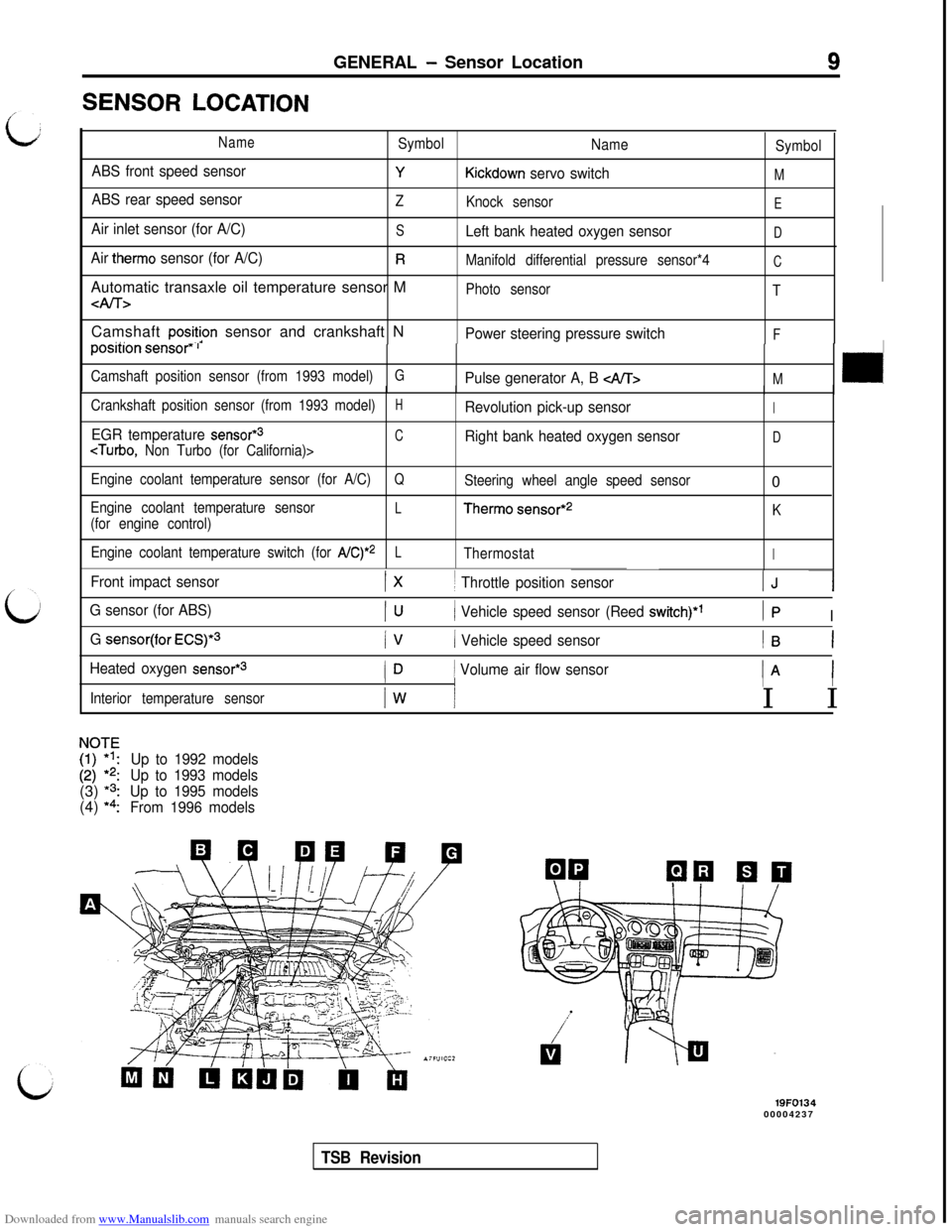
Downloaded from www.Manualslib.com manuals search engine GENERAL - Sensor Location9SENSOR
LOCATION
NameSymbol
Name
Symbol
ABS front speed sensorYKickdown servo switchM
ABS rear speed sensorZ
Knock sensorE
Air inlet sensor (for A/C)SLeft bank heated oxygen sensorD
Air therm0 sensor (for A/C)RManifold differential pressure sensor*4CAutomatic transaxle oil temperature sensor M
4lT>Photo sensor
TCamshaft
posit!on sensor and crankshaft N. . .Power steering pressure switchFposrtton sensor” I
Camshaft position sensor (from 1993 model)GPulse generator A, B M
Crankshaft position sensor (from 1993 model)HRevolution pick-up sensorI
EGR temperature sensor*3CcTurbo, Non Turbo (for California)>Right bank heated oxygen sensorD
Engine coolant temperature sensor (for A/C)QSteering wheel angle speed sensor0
Engine coolant temperature sensorL(for engine control)Therm0 sensor*2
K
Engine coolant temperature switch (for
A/C)*2LThermostatI
Front impact sensorIx1 Throttle position sensorIJ 1
G sensor (for ABS)PJ( Vehicle speed sensor (Reed switch)*’Ip I
G sensor(for ECS)*31 Vehicle speed sensorIB 1
Heated oxygen sensor*”ID( Volume air flow sensortA 1/III
Interior temperature sensorIw II I
NOIF
I:;
:
*2:
Up to 1992 models(3)
*3:
Up to 1993 models(4)
*a:
Up to 1995 models
From 1996 models
19FO13400004237
TSB Revision
Page 13 of 738
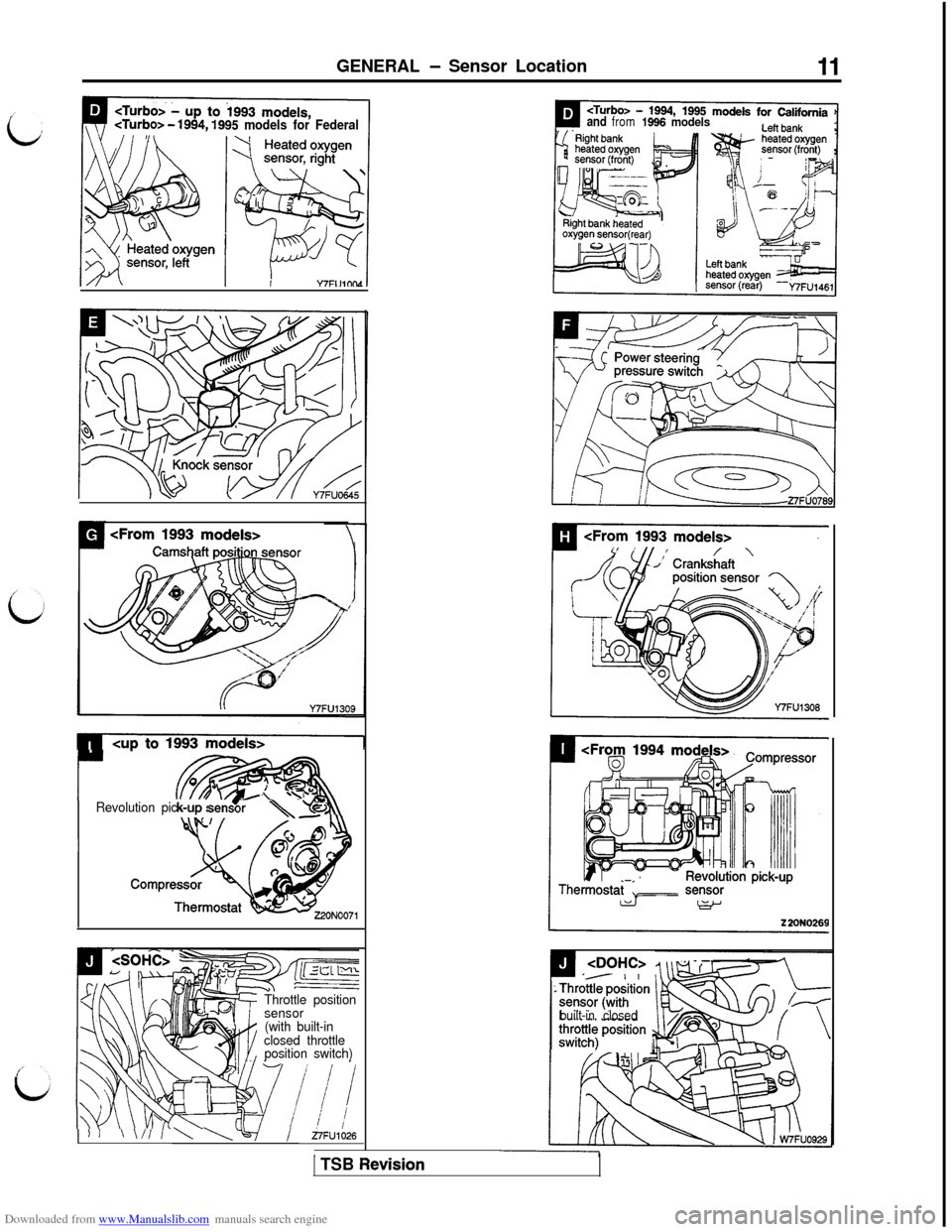
Downloaded from www.Manualslib.com manuals search engine GENERAL - Sensor Location
o> - 1994,1995 models for Federal
CUD to1993models>
r- m0.: \I0
wRevolution pick-up sens’or\u
/c, fdI
Throttle position
sensor
(with built-in
closed throttle
position switch)
and from1966 models
built-in closed
) ) 1\ \l/ / \ \v/~~1026
1 TSB Revision
Page 14 of 738
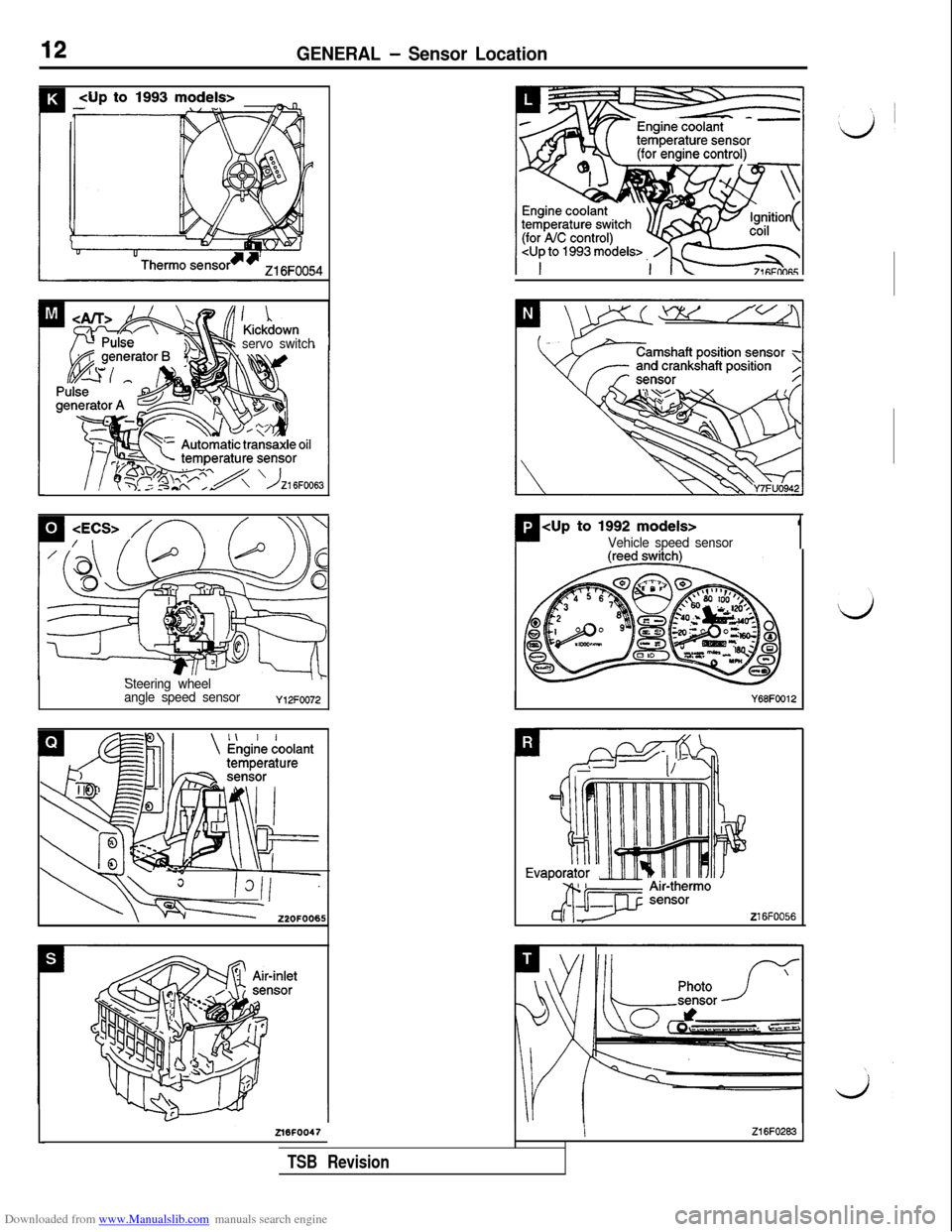
Downloaded from www.Manualslib.com manuals search engine 12GENERAL - Sensor Location
I
> servo switch
LII f$3&FZX ‘AI 6F0063
Steering wheel
angle speed sensorY12FOO72
Vehicle speed sensor1
Y66FOO12
ZWFOO47I216FO26-3
TSB Revision
Page 22 of 738
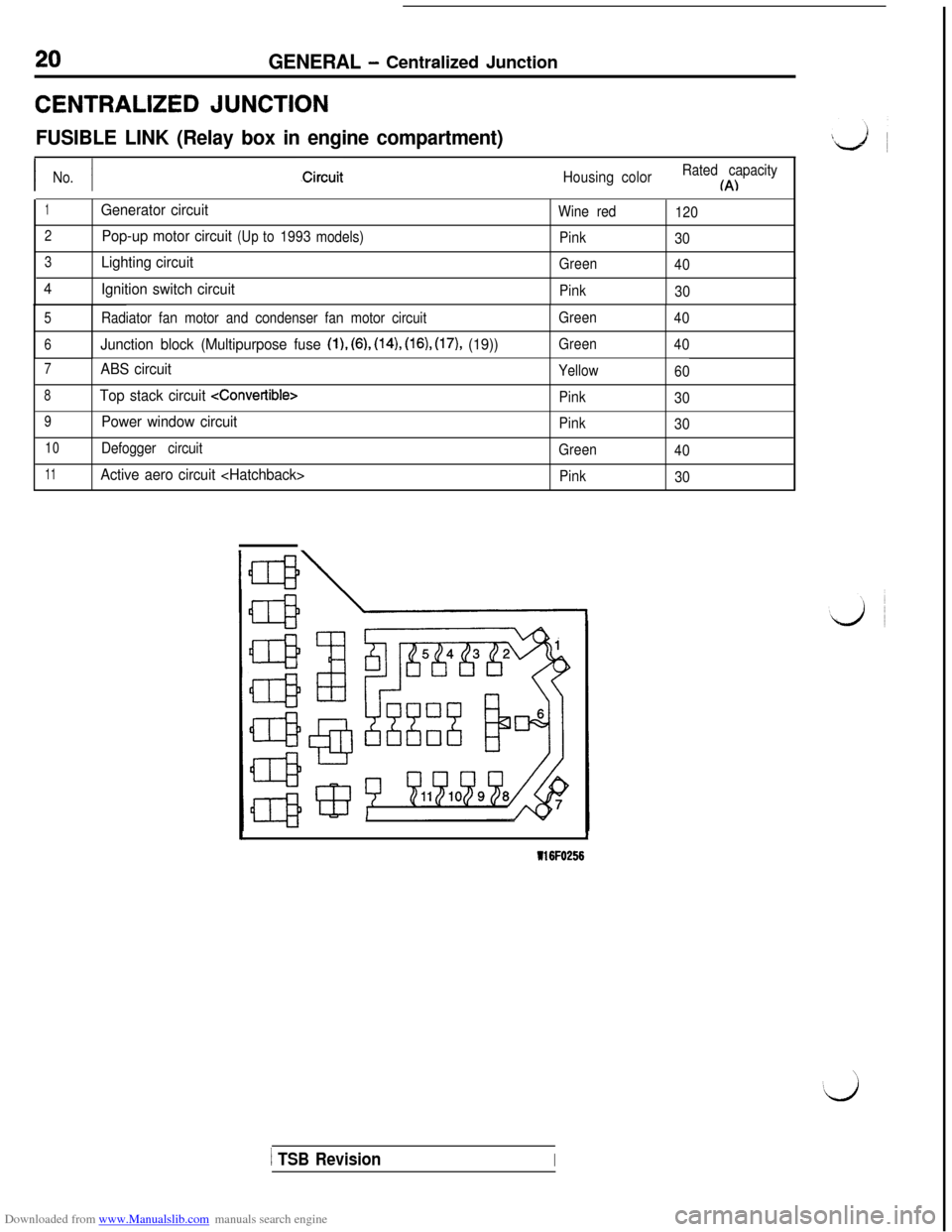
Downloaded from www.Manualslib.com manuals search engine GENERAL - Centralized JunctionCENTRALIZED
JUNCTION
FUSIBLE LINK (Relay box in engine compartment)
I INo.Housing colorRated capacityIA)
1Generator circuitWine red
120
2Pop-up motor circuit(Upto1993
models)
Pink
30
3Lighting circuitGreen
40
4
Ignition switch circuitPink
30
5Radiator fan motor and condenser fan motor circuitGreen
40
6Junction block (Multipurpose fuse (l), (6), (14), (16), (17), (19))Green
40
7ABS circuitYellow
60
8Top stack circuit
Pink
30
9Power window circuitPink
30
10Defogger circuit
Green
40
11Active aero circuit
301I
116FO256
1 TSB RevisionI
Page 24 of 738
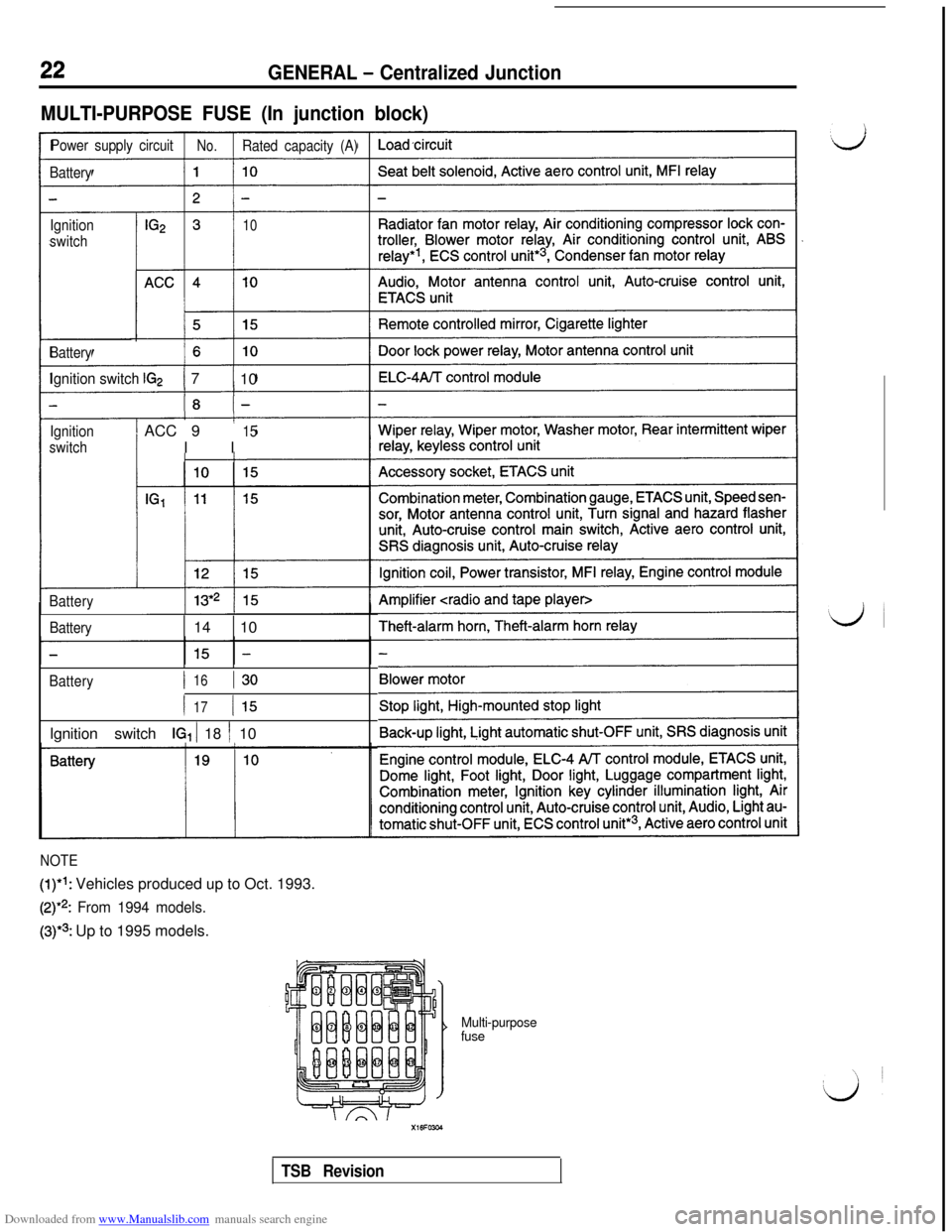
Downloaded from www.Manualslib.com manuals search engine 22GENERAL - Centralized Junction
MULTI-PURPOSE FUSE (In junction block)
Power supply circuitNo.Rated capacity (A)
Battery
Ignition
switch
10
Battery
Ignition switch IG21 7I 10
18 I-
Ignition
switch
BatteryACC 9
I I15
Battery14 10
BatteryI 13016
I 11517Ignition switch
IGl I 18 ( 10
NOTE
(l)*‘: Vehicles produced up to Oct. 1993.
(2)*2: From 1994 models.
(3)*3: Up to 1995 models.
Multi-purpose
fuse
TSB Revision
Page 29 of 738
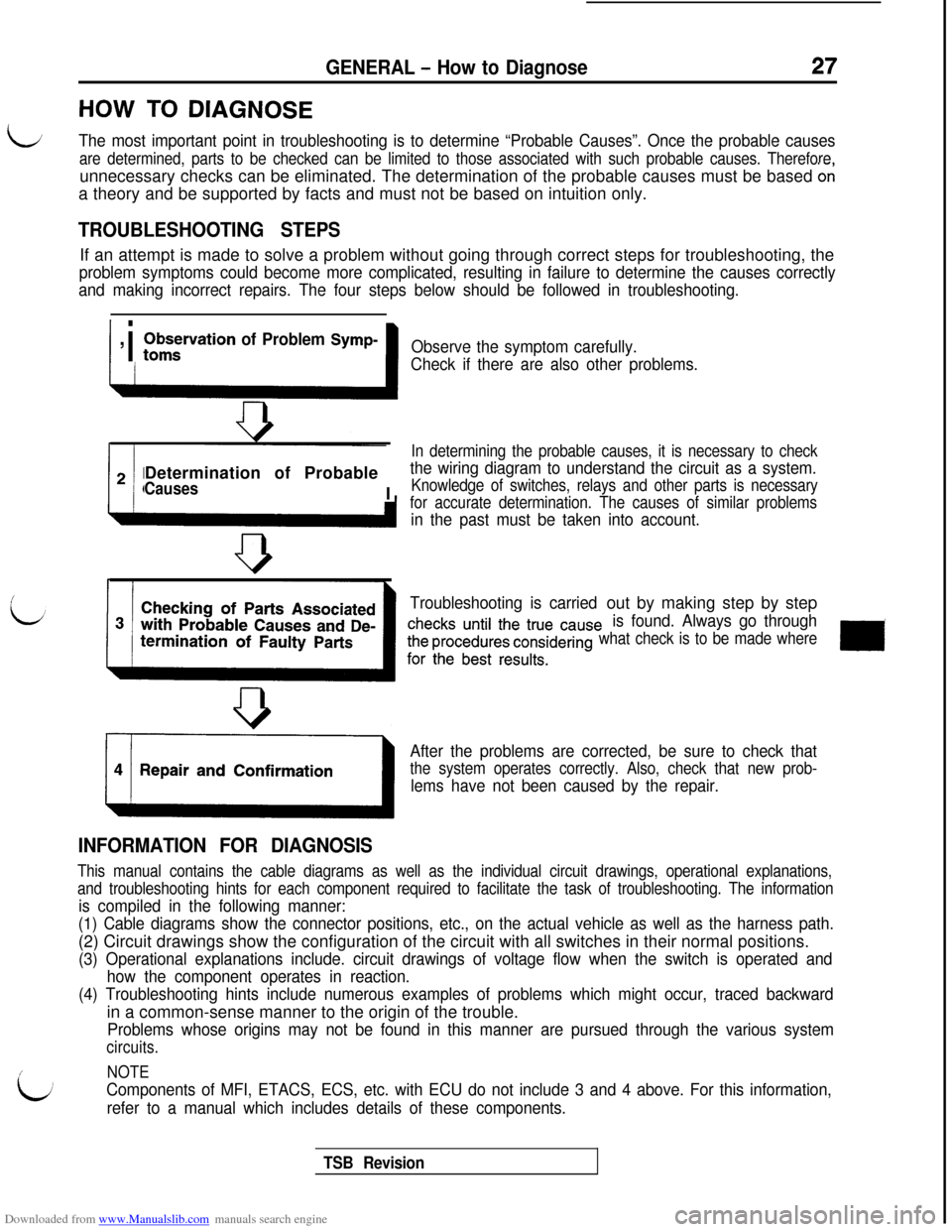
Downloaded from www.Manualslib.com manuals search engine GENERAL - How to Diagnose27
HOW TO DIAGNOSE
L;The most important point in troubleshooting is to determine “Probable Causes”. Once the probable causes
are determined, parts to be checked can be limited to those associated with such probable causes. Thereforeunnecessary checks can be eliminated. The determination of the probable causes must be based
ona theory and be supported by facts and must not be based on intuition only.
TROUBLESHOOTING STEPSIf an attempt is made to solve a problem without going through correct steps for troubleshooting, the
problem symptoms could become more complicated, resulting in failure to determine the causes correctly
and making incorrect repairs. The four steps below should be followed in troubleshooting.
I i
,;zirvation of Problem Symp-Determination of Probable
CausesI
Observe the symptom carefully.
Check if there are also other problems.
In determining the probable causes, it is necessary to check
the wiring diagram to understand the circuit as a system.
Knowledge of switches, relays and other parts is necessary
for accurate determination. The causes of similar problems
in the past must be taken into account.
After the problems are corrected, be sure to check that
the system operates correctly. Also, check that new prob-
lems have not been caused by the repair.
INFORMATION FOR DIAGNOSIS
Troubleshooting is carriedout by making step by step
is found. Always go through
what check is to be made where
/
b
This manual contains the cable diagrams as well as the individual circuit drawings, operational explanations,
and troubleshooting hints for each component required to facilitate the task of troubleshooting. The information
is compiled in the following manner:
(1) Cable diagrams show the connector positions, etc., on the actual vehicle as well as the harness path.(2) Circuit drawings show the configuration of the circuit with all switches in their normal positions.
(3) Operational explanations include. circuit drawings of voltage flow when the switch is operated and
how the component operates in reaction.
(4) Troubleshooting hints include numerous examples of problems which might occur, traced backwardin a common-sense manner to the origin of the trouble.
Problems whose origins may not be found in this manner are pursued through the various system
circuits.
NOTE
Components of MFI, ETACS, ECS, etc. with ECU do not include 3 and 4 above. For this information,
refer to a manual which includes details of these components.
TSB Revision
Page 31 of 738
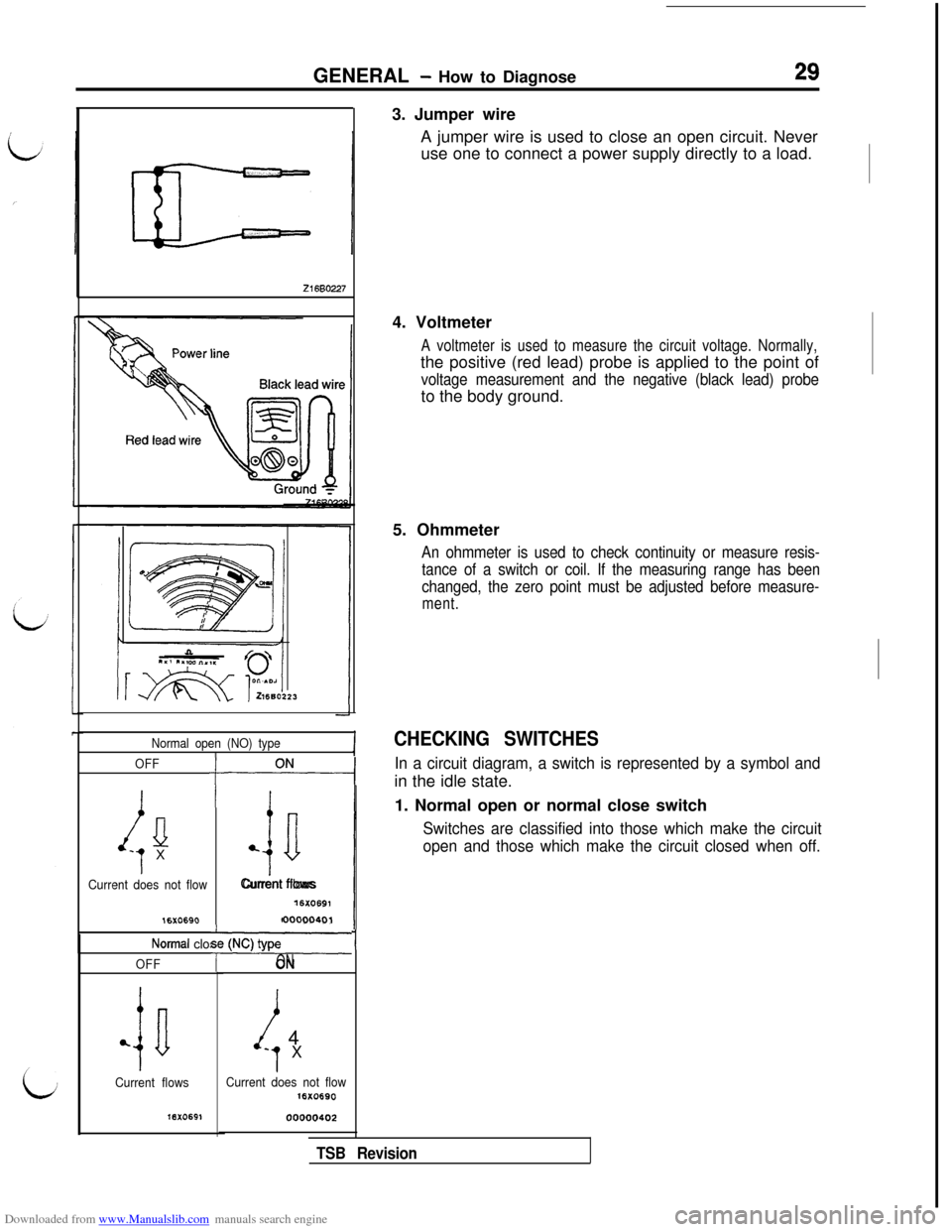
Downloaded from www.Manualslib.com manuals search engine GENERAL - How to Diagnose293. Jumper wire
A jumper wire is used to close an open circuit. Never
use one to connect a power supply directly to a load.
Z16602274. Voltmeter
A voltmeter is used to measure the circuit voltage. Normally,the positive (red lead) probe is applied to the point of
voltage measurement and the negative (black lead) probeto the body ground.
5. Ohmmeter
An ohmmeter is used to check continuity or measure resis-
tance of a switch or coil. If the measuring range has been
changed, the zero point must be adjusted before measure-
ment.
CHECKING SWITCHES
In a circuit diagram, a switch is represented by a symbol andin the idle state.
1. Normal open or normal close switch
Switches are classified into those which make the circuit
open and those which make the circuit closed when off.
INormal open (NO) typeIOFF
/4-
1X
t
Current does not flow
16X0690
ON
1
a
ia
Current flows
16X0691
00000401
Normal close (NC) type
i===ONOFF
1
/4-
1X
Current does not flow16X0690
00000402
a
III
Current flows
16X0691
TSB Revision
Page 32 of 738
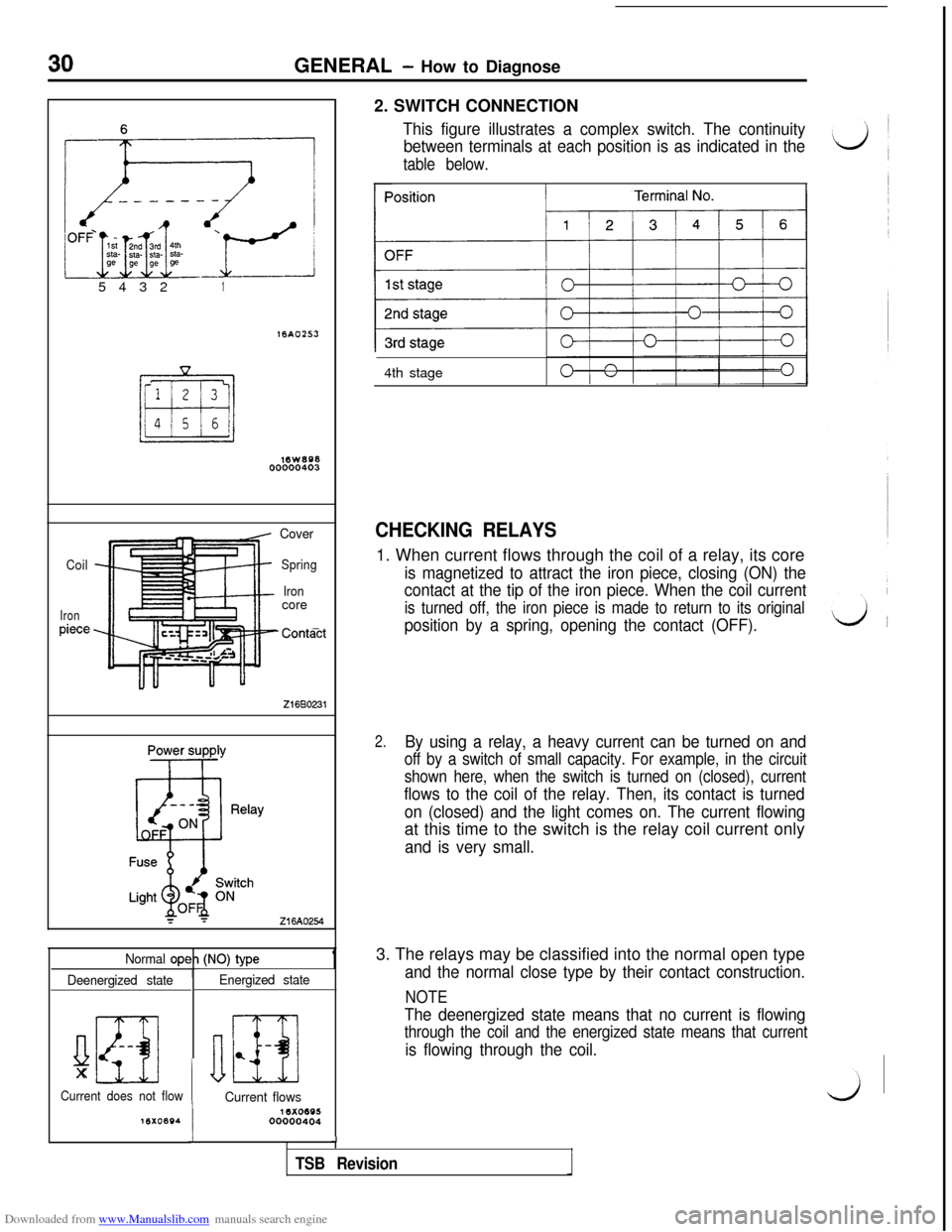
Downloaded from www.Manualslib.com manuals search engine 30GENERAL - How to Diagnose
5432
1
18AO253
10W80800000403
Coil
Iron
Cover
Spring
Iron
core
- ContZt
21680231
(NO) type
Energized state1Normal op6
Deenergized state
--
nKilX
Current does not flow
lSXO804
!
Current flows10x0095000004042. SWITCH CONNECTION
This figure illustrates a complex switch. The continuity
between terminals at each position is as indicated in the
table below.4th stage
CHECKING RELAYS1. When current flows through the coil of a relay, its core
is magnetized to attract the iron piece, closing (ON) the
contact at the tip of the iron piece. When the coil current
is turned off, the iron piece is made to return to its original
position by a spring, opening the contact (OFF).
2.By using a relay, a heavy current can be turned on and
off by a switch of small capacity. For example, in the circuit
shown here, when the switch is turned on (closed), current
flows to the coil of the relay. Then, its contact is turned
on (closed) and the light comes on. The current flowingat this time to the switch is the relay coil current only
and is very small.3. The relays may be classified into the normal open type
and the normal close type by their contact construction.
NOTE
The deenergized state means that no current is flowing
through the coil and the energized state means that current
is flowing through the coil.
JI
TSB Revision
Page 33 of 738
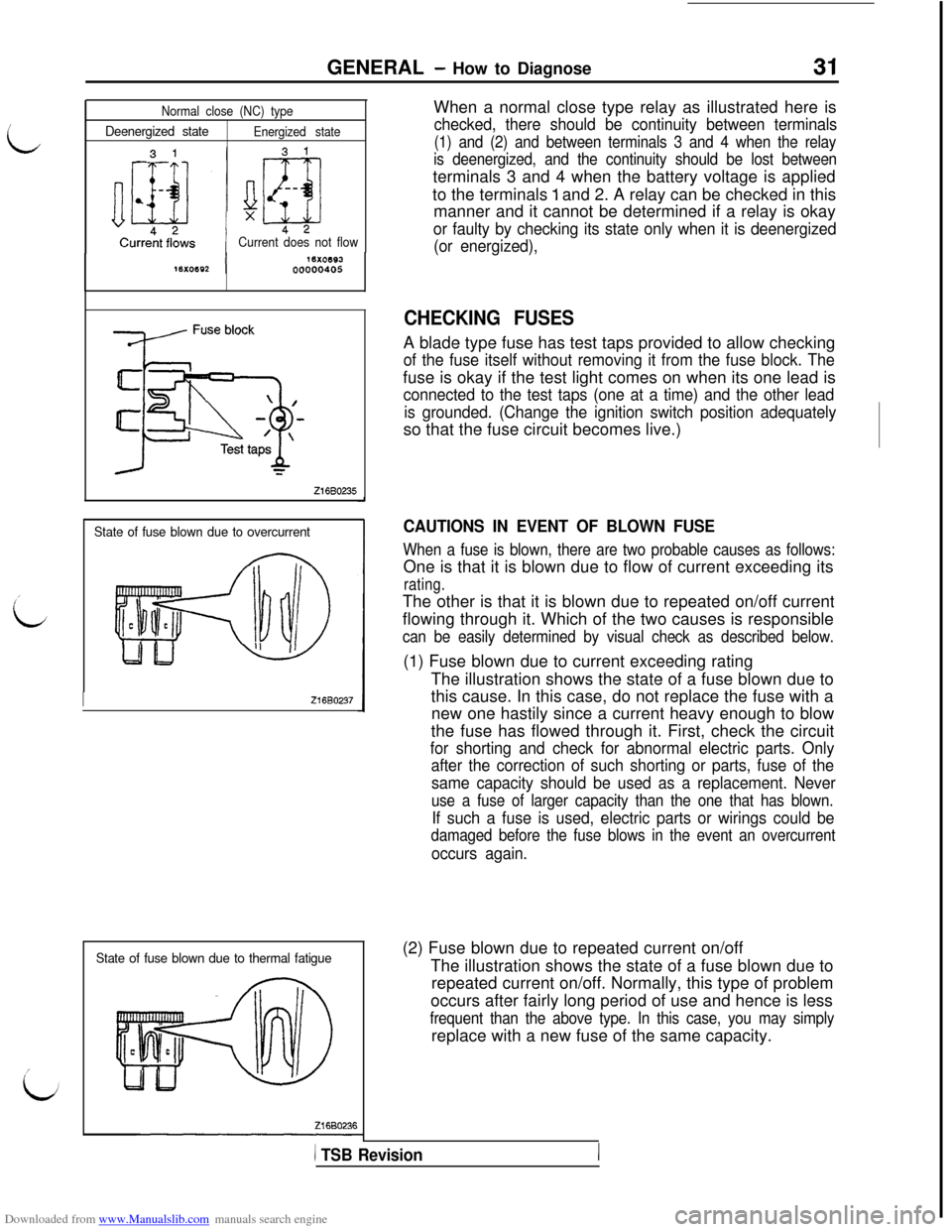
Downloaded from www.Manualslib.com manuals search engine iGENERAL
- How to Diagnose31
Normal close (NC) type
Deenergized stateEnergized state
Current does not flow
Z1680235
State of fuse blown due to overcurrent
/
L
I21680237
State of fuse blown due to thermal fatigue
Z1660236When a normal close type relay as illustrated here is
checked, there should be continuity between terminals
(1) and (2) and between terminals 3 and 4 when the relay
is deenergized, and the continuity should be lost betweenterminals 3 and 4 when the battery voltage is applied
to the terminals
1 and 2. A relay can be checked in this
manner and it cannot be determined if a relay is okay
or faulty by checking its state only when it is deenergized
(or energized),
CHECKING FUSESA blade type fuse has test taps provided to allow checking
of the fuse itself without removing it from the fuse block. Thefuse is okay if the test light comes on when its one lead is
connected to the test taps (one at a time) and the other lead
is grounded. (Change the ignition switch position adequatelyso that the fuse circuit becomes live.)
CAUTIONS IN EVENT OF BLOWN FUSE
When a fuse is blown, there are two probable causes as follows:One is that it is blown due to flow of current exceeding its
rating.The other is that it is blown due to repeated on/off current
flowing through it. Which of the two causes is responsible
can be easily determined by visual check as described below.(1) Fuse blown due to current exceeding rating
The illustration shows the state of a fuse blown due to
this cause. In this case, do not replace the fuse with a
new one hastily since a current heavy enough to blow
the fuse has flowed through it. First, check the circuit
for shorting and check for abnormal electric parts. Only
after the correction of such shorting or parts, fuse of the
same capacity should be used as a replacement. Never
use a fuse of larger capacity than the one that has blown.
If such a fuse is used, electric parts or wirings could be
damaged before the fuse blows in the event an overcurrent
occurs again.(2) Fuse blown due to repeated current on/off
The illustration shows the state of a fuse blown due to
repeated current on/off. Normally, this type of problem
occurs after fairly long period of use and hence is less
frequent than the above type. In this case, you may simplyreplace with a new fuse of the same capacity.
1 TSB Revision
Page 34 of 738
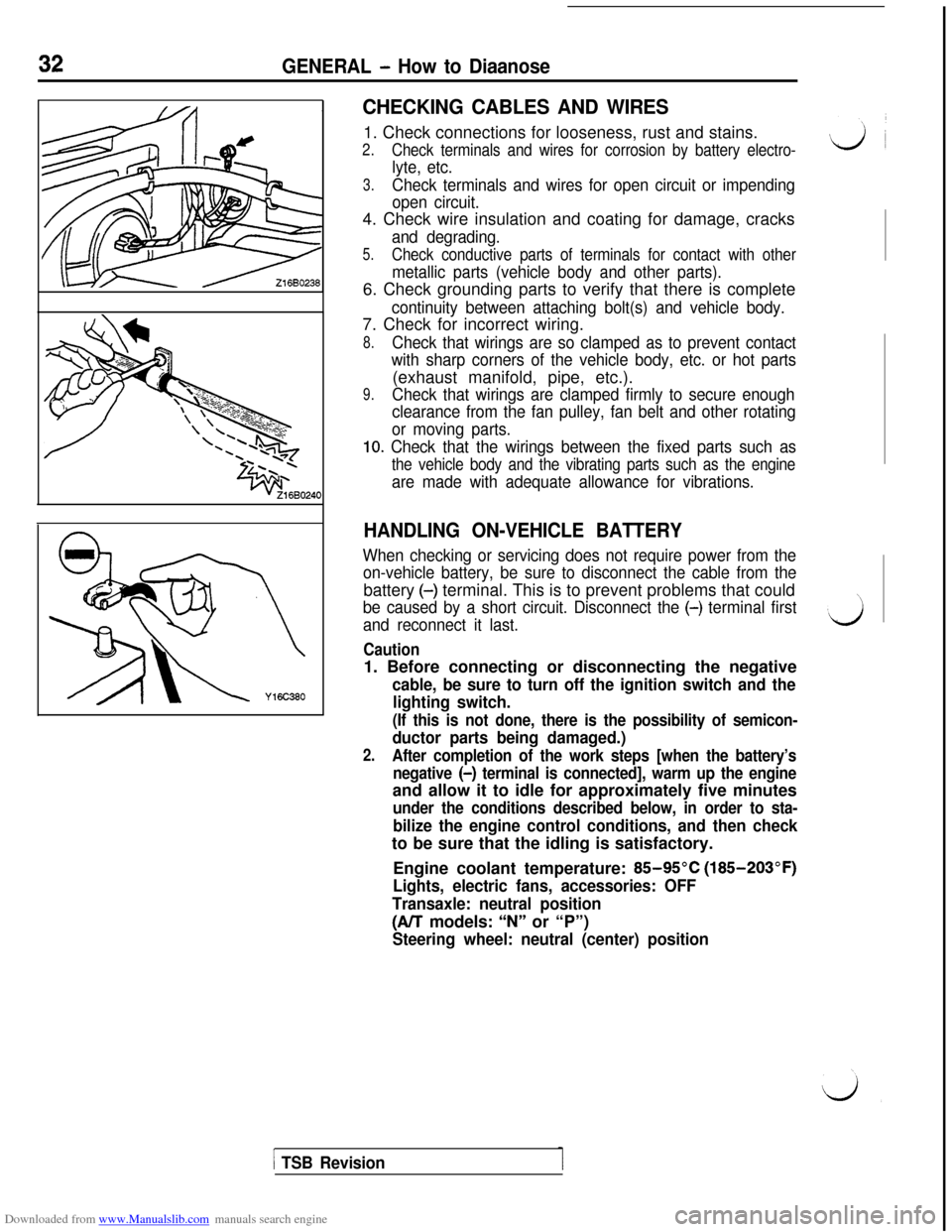
Downloaded from www.Manualslib.com manuals search engine 32GENERAL - How to Diaanose
CHECKING CABLES AND WIRES1. Check connections for looseness, rust and stains.
2.Check terminals and wires for corrosion by battery electro-
lyte, etc.
3.Check terminals and wires for open circuit or impending
open circuit.4. Check wire insulation and coating for damage, cracks
and degrading.
5.Check conductive parts of terminals for contact with other
metallic parts (vehicle body and other parts).6. Check grounding parts to verify that there is complete
continuity between attaching bolt(s) and vehicle body.7. Check for incorrect wiring.
8.Check that wirings are so clamped as to prevent contact
with sharp corners of the vehicle body, etc. or hot parts(exhaust manifold, pipe, etc.).
9.Check that wirings are clamped firmly to secure enough
clearance from the fan pulley, fan belt and other rotating
or moving parts.
10. Check that the wirings between the fixed parts such as
the vehicle body and the vibrating parts such as the engine
are made with adequate allowance for vibrations.
HANDLING ON-VEHICLE BATTERY
When checking or servicing does not require power from the
on-vehicle battery, be sure to disconnect the cable from thebattery
(-) terminal. This is to prevent problems that could
be caused by a short circuit. Disconnect the (-) terminal first
and reconnect it last.
Caution1. Before connecting or disconnecting the negative
cable, be sure to turn off the ignition switch and the
lighting switch.
(If this is not done, there is the possibility of semicon-
ductor parts being damaged.)
2.After completion of the work steps [when the battery’s
negative (-)
terminal is connected], warm up the engineand allow it to idle for approximately five minutes
under the conditions described below, in order to sta-
bilize the engine control conditions, and then checkto be sure that the idling is satisfactory.
Engine coolant temperature:
85-95°C (185-203°F)
Lights, electric fans, accessories: OFF
Transaxle: neutral position
(A/T models: “N” or “P”)
Steering wheel: neutral (center) position
1 TSB Revision